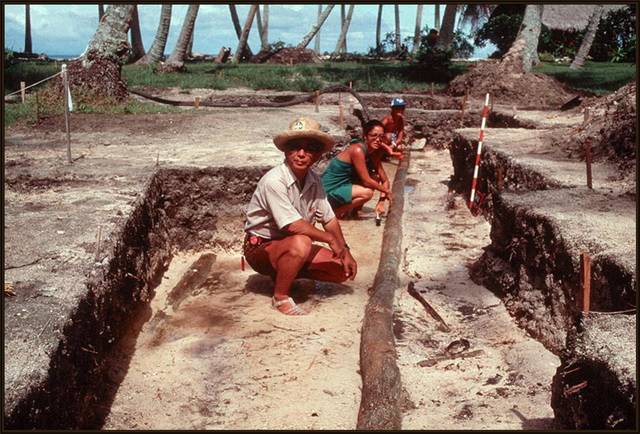In memory: Anthropologist Sinoto’s work key to understanding Polynesian migration

COURTESY BISHOP MUSEUM
The research and fieldwork of renowned Bishop Museum anthropologist Yosihiko Sinoto laid the foundation for our understanding of Polynesian migration. Sinoto discovered the mast of an ancient voyaging canoe during a dig in Huahine, French Polynesia, in 1979.
Internationally renowned anthropologist Yosihiko Sinoto, whose archaeological work spanned more than 60 years and provided the basis for understanding the Polynesian migration, died Wednesday of natural causes at age 93.
“He was a giant in the field of Polynesian archaeology,” said Bishop Museum board member and archaeologist Patrick Kirch by phone from his home in California. His work was “fundamental in the understanding of the settlement of eastern Polynesia and the Hawaiian Islands.”
Sinoto did much of the important, early excavation, uncovering key sites in the Marquesas, the Society Islands, Tahiti and at South Point on Hawaii island that showed the sequence and timing of the settlement of Polynesia, Kirch said.
Because no pottery existed in Hawaii, Sinoto’s insight proved invaluable in discovery of fishhooks and adzes.
“He said, ‘Ah, I can use fishhooks,’” Kirch said. “He could tell what island a fishhook came from.”
Some of his momentous discoveries include finding the planks of a voyaging canoe, its mast and steering paddle on Huahine island.
Don't miss out on what's happening!
Stay in touch with breaking news, as it happens, conveniently in your email inbox. It's FREE!
He also discovered one of the very early sites in the Marquesas to be settled.
“Yoshi argued that the Marquesas was the first place to be settled, probably from western Samoa,” Kirch said. “He was tracing the links. The site was rich in artifacts.” From the Marquesas those Polynesians went to Hawaii. His theories of the Polynesian settlement still hold up pretty well today, he said.
Sinoto, who became Bishop Museum’s Kenneth P. Emory Distinguished Chair in Anthropology in 1989, began his work in the 1950s as the protege of Emory, who started at Bishop Museum in 1920.
Born in Tokyo in 1924, Sinoto was headed after the war to the University of California at Berkeley to study but got “shanghaied” by Emory, said his son and only child, Akihiko.
“Emory had heard of this promising young archaeologist, and he was waylaid in Hawaii and never went on to Berkeley,” Kirch said, spending the next 65 years or so in Pacific archaeology.
Sinoto obtained his undergraduate degree from the University of Hawaii while serving as Emory’s research assistant. He completed his doctoral dissertation on Polynesian fishhooks at Hokkaido University. Upon his return in 1970, he became chairman of the Anthropology Department.
In his role as chairman, he called for stronger preservation laws and educational programs to heighten the public’s understanding of the importance of protecting Hawaii’s endangered cultural legacy, Bishop Museum said in a news release.
While Emory was more of an ethnologist, who didn’t know the techniques of archaeology, “Sinoto knew how to dig and classify pottery and work as an archaeologist,” Kirch said.
“Sinoto’s great thing were fishhooks in Polynesia,” he said. Fishhooks — the details, curvature, the head of the hook, whether carved, with notches or nobs, tracing styles — were his great passion, Kirch said.
Kirch describes his former boss as a “wonderful man, gentle, kind. He was a wonderful person. We’ll miss him.”
“I think his strength was that he really got close to the people with the areas that he studied,” said his son, who is also an archaeologist.
On a visit three years ago to Tahiti, Yosihiko Sinoto, who was fluent in Tahitian, was overjoyed when after 50 years people came up to him and said, “Now we understand what you were doing. You were preserving our culture for us and our kids,” his son related.
“Besides his research, he really applied his research to give back to the local people because he wanted to find out the origins of the people in Hawaii and to go back to the places from where they came.”
Among his many awards, Sinoto in 2000 was named chevalier (knight) of the Order of Tahiti Nui by the government in Tahiti. He was also honored with the Order of the Rising Sun, Gold and Silver Rays, from the emperor of Japan in 1995.
Bishop Museum’s interim president and chief executive officer, Linda Lee Kuuleilani Farm, said, “Dr. Sinoto is recognized globally and will long be cherished for his tremendous achievements and contributions to the world’s understanding of Pacific peoples and their history.”



